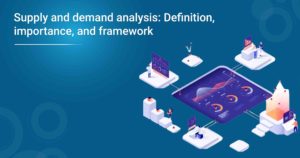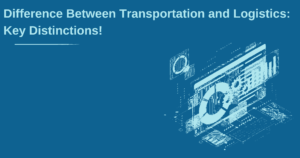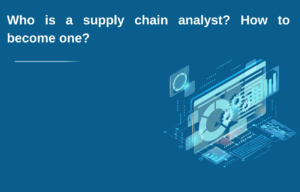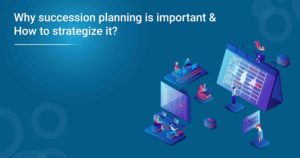Design thinking is a problem-solving approach that involves empathizing with the user, defining the problem, ideating solutions, prototyping, and testing. It has become increasingly popular in recent years as businesses and organizations realize the benefits of a user-centred approach to innovation. This Blog on “What is Design Thinking?” will give you a brief understanding of design thinking. So, let’s get started!
Contents:
- What is Design Thinking?
- The Design Thinking Process
- Benefits of Design Thinking
- Examples of Design Thinking in Action
What is Design Thinking?
Design thinking is a problem-solving approach that has its roots in the field of design. It emerged in the 1960s and 1970s as a response to the limitations of traditional design methods, which were seen as too focused on aesthetics and form rather than function and user needs.
The term “design thinking” was first coined by the design theorist Rolf Faste at Stanford University in the 1980s. Faste argued that design thinking was not just a process for creating beautiful objects, but a way of approaching complex problems and finding innovative solutions.
It began to gain popularity in the 1990s and 2000s, as companies like IDEO, a leading design consultancy, began to use it to develop new products and services. IDEO’s founder, David Kelley, is often credited with popularizing the concept of design thinking and making it more accessible to non-designers.
Today, design thinking has become a widely adopted problem-solving approach, used by businesses, organizations, and individuals around the world. It has evolved beyond its origins in the field of design to become a cross-disciplinary approach that can be applied to a wide range of challenges and industries.
The Design Thinking Process
The design thinking process is typically broken down into five stages: empathize, define, ideate, prototype, and test.
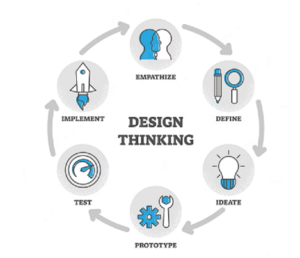
- Empathize
The first stage of the design thinking process is empathizing with the user. This involves putting yourself in the shoes of the user and understanding their needs, wants, and desires. This stage is crucial because it helps designers gain a deep understanding of the user’s perspective and identify the root causes of the problem they are trying to solve.
To empathize with the user, designers might conduct interviews, observe them in their natural environment, or even immerse themselves in the user’s experience.
- Define
Once designers have a deep understanding of the user’s needs, they move on to the second stage of the design thinking process: defining the problem. This involves synthesizing the information gathered during the empathy stage and identifying the key insights.
During the define stage, designers might create a user persona, which is a fictional representation of the user that captures their needs, wants, and desires. This helps designers keep the user at the centre of the problem-solving process and ensures that the solutions they come up with are relevant and meaningful.
- Ideate
The third stage of the design thinking process is ideation. This is where designers generate a wide range of ideas and potential solutions to the problem they have defined. There are a variety of ideation techniques that designers might use, including brainstorming, mind mapping, and sketching.
The goal of the ideation stage is to generate as many ideas as possible, without worrying about whether they are feasible or not. This helps designers explore a wide range of possibilities and find new and innovative solutions to the problem.
- Prototype
Once designers have generated a range of ideas, they move on to the fourth stage of the design thinking process: prototyping. This involves creating a physical or digital representation of the solution or solutions they have come up with.
Prototyping is important because it allows designers to test their ideas in a low-risk environment and get feedback from users. This helps designers refine their ideas and ensure that the final solution they develop is the best possible solution for the user.
- Test
The final stage of the design thinking process is testing. This involves putting the prototype in front of users and getting their feedback. The feedback gathered during the testing stage is used to refine the solution and make any necessary changes.
Testing is important because it ensures that the final solution is relevant and meaningful to the user. It also helps designers identify any potential problems or issues with the solution before it is launched.
Benefits of Design Thinking
It offers a number of benefits to businesses and organizations, including:
- User-centred solutions: It ensures that the solutions developed are centred around the needs and desires of the user, resulting in solutions that are more relevant and meaningful.
- Innovation: It encourages the exploration of new and innovative solutions, resulting in more creative and effective solutions to problems.
- Collaboration: It is a collaborative process that involves multiple stakeholders, including designers, engineers, and users. This helps ensure that a wide range of perspectives and ideas are considered, resulting in more diverse and inclusive solutions.
- Agility: It is a flexible and iterative process, allowing for quick adjustments and changes to be made as new information is gathered. This enables businesses and organizations to respond to changing circumstances and stay ahead of the competition.
- Cost-effectiveness: It can help businesses and organizations save money by identifying and addressing problems early on in the development process. This can help prevent costly mistakes and reduce the risk of product failure.
Examples of Design Thinking in Action
Design thinking has been used by a wide range of businesses and organizations, from small startups to large corporations. Here are a few examples:

Airbnb used design thinking to revamp its user experience, resulting in a more streamlined and intuitive platform. By empathizing with its users and understanding their needs, Airbnb was able to create a more user-centred experience that has helped them become one of the most successful sharing economy companies.
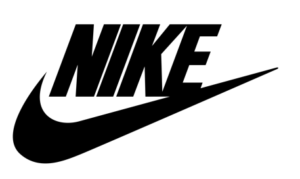
Nike used it to develop their Flyknit technology, which revolutionized the way athletic shoes are made. By ideating and prototyping a new way of creating shoes, Nike was able to create a product that was more lightweight, breathable, and environmentally friendly.

IDEO.org is a nonprofit organization that uses design thinking to tackle complex social problems, such as poverty and inequality. By empathizing with the communities they serve and understanding their needs and desires, IDEO.org has been able to create innovative and effective solutions to these difficult challenges.
Conclusion
Design thinking is a powerful problem-solving approach that can help businesses and organizations develop more innovative and user-centred solutions. By empathizing with the user, defining the problem, ideating solutions, prototyping, and testing, designers can create solutions that are more effective, efficient, and cost-effective.
It is not just for designers, but can be used by anyone who is looking to solve a problem in a creative and effective way. By embracing the principles of design thinking, businesses and organizations can stay ahead of the competition, save money, and make a positive impact on the world around them.
This brings us to the end of this blog on UI UX designs interview questions and answers. Hope I was able to clearly explain all the UI UX designs interview questions and answers
If you want to get trained in UI UX Design and wish to develop interesting UIs on your own, then check out the Ui/UX design offered by Edureka, Our UI/UX design course, curated by industry experts that will help you to master all its concepts.
Got a question for us? Please mention it in the comments section and we will get back to you.













